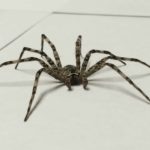 This big hairy spider is often confused with a tarantula, but unless you’re at a pet store, chances are it is actually a Wolf Spider. As a result of a leg span of up to four inches, when we encounter a Wolf Spider during it’s nightly hunt for prey, the mistaken identity is very understandable.
This big hairy spider is often confused with a tarantula, but unless you’re at a pet store, chances are it is actually a Wolf Spider. As a result of a leg span of up to four inches, when we encounter a Wolf Spider during it’s nightly hunt for prey, the mistaken identity is very understandable.
During the course of their nightly wanderings, Wolf Spiders frequently find easy access into our homes under doors and windows. One spider by itself might not be a big deal but what about 100 spiders? Female Wolf Spiders carry their egg sacks on their abdomens because of their wandering habits. After hatching the spiderlings stay on Mom’s back for several weeks until they can fend for themselves. Now, just imagine “Mom” crawls under your garage door early one morning just as her young are “being weaned”. Suddenly checking the weather stripping and door sweep takes on a new importance!
As predators of Black Widow spiders and crawling insects, Wolf Spiders are a common resident of most outdoor habitats where their food source is often plentiful. Because they rarely have permanent homes, Wolf Spiders wander at night in search of a meal or a place to seek refuge until the next evening’s hunt. To assist with the success of the hunt, Wolf Spiders are typically patterned in black, grey and brown shades which camouflages their presence.
Because Wolf Spiders feed on insects and other spiders, minimizing the presence of their food source will reduce a spider population. Many insects are attracted to the exterior lighting frequently found outside a home. Replacing standard light bulbs with sodium vapor light bulbs will attract fewer insects aka spider food. An additional insect reduction measure would be to maintain a four foot area around the home free of vegetation and clutter which could provide harborage for insects or spiders.
If you should be experiencing an issue with spiders, or any other pest, please contact Mr. Bugg’s Pest Patrol today for an evaluation and solution.

